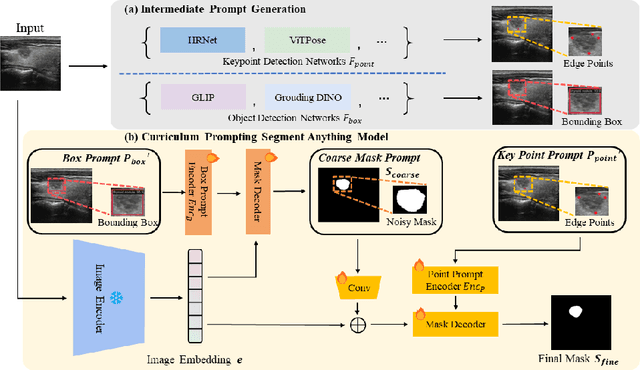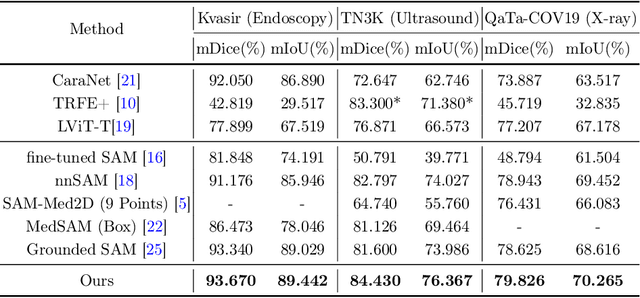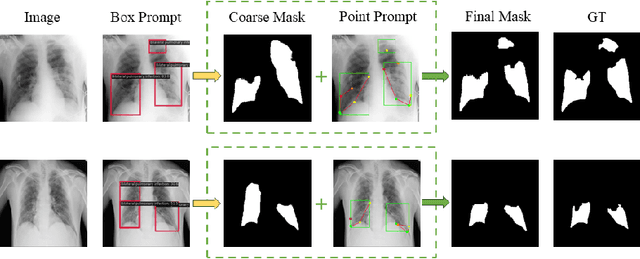Yuhang Zhang
Prototypical Progressive Alignment and Reweighting for Generalizable Semantic Segmentation
Jul 16, 2025Abstract:Generalizable semantic segmentation aims to perform well on unseen target domains, a critical challenge due to real-world applications requiring high generalizability. Class-wise prototypes, representing class centroids, serve as domain-invariant cues that benefit generalization due to their stability and semantic consistency. However, this approach faces three challenges. First, existing methods often adopt coarse prototypical alignment strategies, which may hinder performance. Second, naive prototypes computed by averaging source batch features are prone to overfitting and may be negatively affected by unrelated source data. Third, most methods treat all source samples equally, ignoring the fact that different features have varying adaptation difficulties. To address these limitations, we propose a novel framework for generalizable semantic segmentation: Prototypical Progressive Alignment and Reweighting (PPAR), leveraging the strong generalization ability of the CLIP model. Specifically, we define two prototypes: the Original Text Prototype (OTP) and Visual Text Prototype (VTP), generated via CLIP to serve as a solid base for alignment. We then introduce a progressive alignment strategy that aligns features in an easy-to-difficult manner, reducing domain gaps gradually. Furthermore, we propose a prototypical reweighting mechanism that estimates the reliability of source data and adjusts its contribution, mitigating the effect of irrelevant or harmful features (i.e., reducing negative transfer). We also provide a theoretical analysis showing the alignment between our method and domain generalization theory. Extensive experiments across multiple benchmarks demonstrate that PPAR achieves state-of-the-art performance, validating its effectiveness.
Grounded Vision-Language Navigation for UAVs with Open-Vocabulary Goal Understanding
Jun 12, 2025Abstract:Vision-and-language navigation (VLN) is a long-standing challenge in autonomous robotics, aiming to empower agents with the ability to follow human instructions while navigating complex environments. Two key bottlenecks remain in this field: generalization to out-of-distribution environments and reliance on fixed discrete action spaces. To address these challenges, we propose Vision-Language Fly (VLFly), a framework tailored for Unmanned Aerial Vehicles (UAVs) to execute language-guided flight. Without the requirement for localization or active ranging sensors, VLFly outputs continuous velocity commands purely from egocentric observations captured by an onboard monocular camera. The VLFly integrates three modules: an instruction encoder based on a large language model (LLM) that reformulates high-level language into structured prompts, a goal retriever powered by a vision-language model (VLM) that matches these prompts to goal images via vision-language similarity, and a waypoint planner that generates executable trajectories for real-time UAV control. VLFly is evaluated across diverse simulation environments without additional fine-tuning and consistently outperforms all baselines. Moreover, real-world VLN tasks in indoor and outdoor environments under direct and indirect instructions demonstrate that VLFly achieves robust open-vocabulary goal understanding and generalized navigation capabilities, even in the presence of abstract language input.
FM-Planner: Foundation Model Guided Path Planning for Autonomous Drone Navigation
May 27, 2025Abstract:Path planning is a critical component in autonomous drone operations, enabling safe and efficient navigation through complex environments. Recent advances in foundation models, particularly large language models (LLMs) and vision-language models (VLMs), have opened new opportunities for enhanced perception and intelligent decision-making in robotics. However, their practical applicability and effectiveness in global path planning remain relatively unexplored. This paper proposes foundation model-guided path planners (FM-Planner) and presents a comprehensive benchmarking study and practical validation for drone path planning. Specifically, we first systematically evaluate eight representative LLM and VLM approaches using standardized simulation scenarios. To enable effective real-time navigation, we then design an integrated LLM-Vision planner that combines semantic reasoning with visual perception. Furthermore, we deploy and validate the proposed path planner through real-world experiments under multiple configurations. Our findings provide valuable insights into the strengths, limitations, and feasibility of deploying foundation models in real-world drone applications and providing practical implementations in autonomous flight. Project site: https://github.com/NTU-ICG/FM-Planner.
Towards Human-Centric Autonomous Driving: A Fast-Slow Architecture Integrating Large Language Model Guidance with Reinforcement Learning
May 11, 2025Abstract:Autonomous driving has made significant strides through data-driven techniques, achieving robust performance in standardized tasks. However, existing methods frequently overlook user-specific preferences, offering limited scope for interaction and adaptation with users. To address these challenges, we propose a "fast-slow" decision-making framework that integrates a Large Language Model (LLM) for high-level instruction parsing with a Reinforcement Learning (RL) agent for low-level real-time decision. In this dual system, the LLM operates as the "slow" module, translating user directives into structured guidance, while the RL agent functions as the "fast" module, making time-critical maneuvers under stringent latency constraints. By decoupling high-level decision making from rapid control, our framework enables personalized user-centric operation while maintaining robust safety margins. Experimental evaluations across various driving scenarios demonstrate the effectiveness of our method. Compared to baseline algorithms, the proposed architecture not only reduces collision rates but also aligns driving behaviors more closely with user preferences, thereby achieving a human-centric mode. By integrating user guidance at the decision level and refining it with real-time control, our framework bridges the gap between individual passenger needs and the rigor required for safe, reliable driving in complex traffic environments.
Depth-Sensitive Soft Suppression with RGB-D Inter-Modal Stylization Flow for Domain Generalization Semantic Segmentation
May 11, 2025Abstract:Unsupervised Domain Adaptation (UDA) aims to align source and target domain distributions to close the domain gap, but still struggles with obtaining the target data. Fortunately, Domain Generalization (DG) excels without the need for any target data. Recent works expose that depth maps contribute to improved generalized performance in the UDA tasks, but they ignore the noise and holes in depth maps due to device and environmental factors, failing to sufficiently and effectively learn domain-invariant representation. Although high-sensitivity region suppression has shown promising results in learning domain-invariant features, existing methods cannot be directly applicable to depth maps due to their unique characteristics. Hence, we propose a novel framework, namely Depth-Sensitive Soft Suppression with RGB-D inter-modal stylization flow (DSSS), focusing on learning domain-invariant features from depth maps for the DG semantic segmentation. Specifically, we propose the RGB-D inter-modal stylization flow to generate stylized depth maps for sensitivity detection, cleverly utilizing RGB information as the stylization source. Then, a class-wise soft spatial sensitivity suppression is designed to identify and emphasize non-sensitive depth features that contain more domain-invariant information. Furthermore, an RGB-D soft alignment loss is proposed to ensure that the stylized depth maps only align part of the RGB features while still retaining the unique depth information. To our best knowledge, our DSSS framework is the first work to integrate RGB and Depth information in the multi-class DG semantic segmentation task. Extensive experiments over multiple backbone networks show that our framework achieves remarkable performance improvement.
Evaluating Human Perception of Novel View Synthesis: Subjective Quality Assessment of Gaussian Splatting and NeRF in Dynamic Scenes
Jan 13, 2025Abstract:Gaussian Splatting (GS) and Neural Radiance Fields (NeRF) are two groundbreaking technologies that have revolutionized the field of Novel View Synthesis (NVS), enabling immersive photorealistic rendering and user experiences by synthesizing multiple viewpoints from a set of images of sparse views. The potential applications of NVS, such as high-quality virtual and augmented reality, detailed 3D modeling, and realistic medical organ imaging, underscore the importance of quality assessment of NVS methods from the perspective of human perception. Although some previous studies have explored subjective quality assessments for NVS technology, they still face several challenges, especially in NVS methods selection, scenario coverage, and evaluation methodology. To address these challenges, we conducted two subjective experiments for the quality assessment of NVS technologies containing both GS-based and NeRF-based methods, focusing on dynamic and real-world scenes. This study covers 360{\deg}, front-facing, and single-viewpoint videos while providing a richer and greater number of real scenes. Meanwhile, it's the first time to explore the impact of NVS methods in dynamic scenes with moving objects. The two types of subjective experiments help to fully comprehend the influences of different viewing paths from a human perception perspective and pave the way for future development of full-reference and no-reference quality metrics. In addition, we established a comprehensive benchmark of various state-of-the-art objective metrics on the proposed database, highlighting that existing methods still struggle to accurately capture subjective quality. The results give us some insights into the limitations of existing NVS methods and may promote the development of new NVS methods.
Face-Human-Bench: A Comprehensive Benchmark of Face and Human Understanding for Multi-modal Assistants
Jan 05, 2025



Abstract:Faces and humans are crucial elements in social interaction and are widely included in everyday photos and videos. Therefore, a deep understanding of faces and humans will enable multi-modal assistants to achieve improved response quality and broadened application scope. Currently, the multi-modal assistant community lacks a comprehensive and scientific evaluation of face and human understanding abilities. In this paper, we first propose a hierarchical ability taxonomy that includes three levels of abilities. Then, based on this taxonomy, we collect images and annotations from publicly available datasets in the face and human community and build a semi-automatic data pipeline to produce problems for the new benchmark. Finally, the obtained Face-Human-Bench comprises a development set with 900 problems and a test set with 1800 problems, supporting both English and Chinese. We conduct evaluations over 25 mainstream multi-modal large language models (MLLMs) with our Face-Human-Bench, focusing on the correlation between abilities, the impact of the relative position of targets on performance, and the impact of Chain of Thought (CoT) prompting on performance. Moreover, inspired by multi-modal agents, we also explore which abilities of MLLMs need to be supplemented by specialist models.
Fleximo: Towards Flexible Text-to-Human Motion Video Generation
Nov 29, 2024



Abstract:Current methods for generating human motion videos rely on extracting pose sequences from reference videos, which restricts flexibility and control. Additionally, due to the limitations of pose detection techniques, the extracted pose sequences can sometimes be inaccurate, leading to low-quality video outputs. We introduce a novel task aimed at generating human motion videos solely from reference images and natural language. This approach offers greater flexibility and ease of use, as text is more accessible than the desired guidance videos. However, training an end-to-end model for this task requires millions of high-quality text and human motion video pairs, which are challenging to obtain. To address this, we propose a new framework called Fleximo, which leverages large-scale pre-trained text-to-3D motion models. This approach is not straightforward, as the text-generated skeletons may not consistently match the scale of the reference image and may lack detailed information. To overcome these challenges, we introduce an anchor point based rescale method and design a skeleton adapter to fill in missing details and bridge the gap between text-to-motion and motion-to-video generation. We also propose a video refinement process to further enhance video quality. A large language model (LLM) is employed to decompose natural language into discrete motion sequences, enabling the generation of motion videos of any desired length. To assess the performance of Fleximo, we introduce a new benchmark called MotionBench, which includes 400 videos across 20 identities and 20 motions. We also propose a new metric, MotionScore, to evaluate the accuracy of motion following. Both qualitative and quantitative results demonstrate that our method outperforms existing text-conditioned image-to-video generation methods. All code and model weights will be made publicly available.
Act in Collusion: A Persistent Distributed Multi-Target Backdoor in Federated Learning
Nov 06, 2024Abstract:Federated learning, a novel paradigm designed to protect data privacy, is vulnerable to backdoor attacks due to its distributed nature. Current research often designs attacks based on a single attacker with a single backdoor, overlooking more realistic and complex threats in federated learning. We propose a more practical threat model for federated learning: the distributed multi-target backdoor. In this model, multiple attackers control different clients, embedding various triggers and targeting different classes, collaboratively implanting backdoors into the global model via central aggregation. Empirical validation shows that existing methods struggle to maintain the effectiveness of multiple backdoors in the global model. Our key insight is that similar backdoor triggers cause parameter conflicts and injecting new backdoors disrupts gradient directions, significantly weakening some backdoors performance. To solve this, we propose a Distributed Multi-Target Backdoor Attack (DMBA), ensuring efficiency and persistence of backdoors from different malicious clients. To avoid parameter conflicts, we design a multi-channel dispersed frequency trigger strategy to maximize trigger differences. To mitigate gradient interference, we introduce backdoor replay in local training to neutralize conflicting gradients. Extensive validation shows that 30 rounds after the attack, Attack Success Rates of three different backdoors from various clients remain above 93%. The code will be made publicly available after the review period.
Curriculum Prompting Foundation Models for Medical Image Segmentation
Sep 01, 2024



Abstract:Adapting large pre-trained foundation models, e.g., SAM, for medical image segmentation remains a significant challenge. A crucial step involves the formulation of a series of specialized prompts that incorporate specific clinical instructions. Past works have been heavily reliant on a singular type of prompt for each instance, necessitating manual input of an ideally correct prompt, which is less efficient. To tackle this issue, we propose to utilize prompts of different granularity, which are sourced from original images to provide a broader scope of clinical insights. However, combining prompts of varying types can pose a challenge due to potential conflicts. In response, we have designed a coarse-to-fine mechanism, referred to as curriculum prompting, that progressively integrates prompts of different types. Through extensive experiments on three public medical datasets across various modalities, we demonstrate the effectiveness of our proposed approach, which not only automates the prompt generation process but also yields superior performance compared to other SAM-based medical image segmentation methods. Code is available at: https://github.com/AnnaZzz-zxq/Curriculum-Prompting.
 Add to Chrome
Add to Chrome Add to Firefox
Add to Firefox Add to Edge
Add to Edge